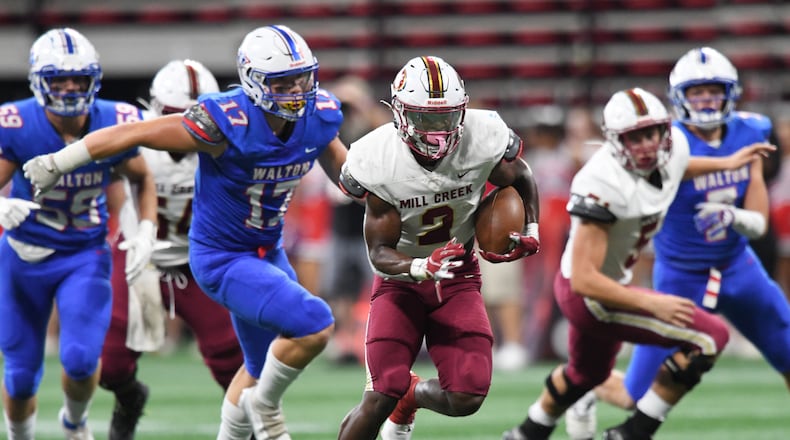Mill Creek senior Caleb Downs is a consensus 5-star safety committed to Alabama. He also has an estimated name, image and likeness (NIL) value of $315,000, according to On3.com, a newly formed online recruiting service launched by Shannon Terry, a former owner of Rivals and founder of 247Sports, that sets a value for high school athletes heading to the next level of competition.
Assigning dollar values to high school athletes may have sounded extreme and exploitative just a few years ago, but with the advent of NIL at the NCAA level, it’s more of a natural progression. The business side of sports no longer can be ignored when it comes to college recruiting, and recruiters are openly pitching players on financial enrichment, in some cases more than the academic institution itself.
The validity of the On3.com NIL values can’t be tested in Georgia because the GHSA prohibits NIL deals for high school athletes. But 16 states and Washington, D.C., allow for high school athletes to profit from NIL.
So could high school athletes in Georgia soon be making pitches for the local hamburger hangout?
Eccker Sports was founded in 2020 to provide high school coaches, administration and players with guidance as they navigate the NIL landscape. Eccker Sports co-founder Tim Prukop said the company helps high schools across the country understand the rules.
“There are challenges because high school kids in California, Louisiana or New York can start participating in NIL opportunities from colleges and local businesses,” Prukop said. “But if a kid in Texas, where NIL deals aren’t allowed, tries to take advantage, he loses his senior eligibility. So he has to decline money.”
At present, none of the Southern states have NIL laws in place for high school athletes. But two Florida high school players are suing the FHSSA, NFHS and NCAA for the right to earn NIL money while playing for their high school teams. The GHSA isn’t monitoring the lawsuit, executive director Robin Hines said, but he’s open to NIL discussions with state legislators.
“I know (the issue of NIL) is something that’s not going away,” Hines said. “We could get into the weeds over it, and I don’t think the NFHS is for NIL, as far as use of a school’s name, jersey, logos and that sort of thing. As far as we’re concerned, high school is absent from the NIL law passed in Georgia. ... I think it’s something that needs to be debated, and it’s totally appropriate for high school associations across the country to have a say in any NIL law that affects them. I’ll be talking with our legislators and the general assembly about NIL, and we’ll ask how we can be of service in those conversations.”
Credit: Courtesy of Eccker Sports
Credit: Courtesy of Eccker Sports
Downs is one of 100 players ranked nationally in On3.com’s national high school football NIL rankings. At No. 13, he’s the second-highest ranked player in Georgia, behind Brookwood senior quarterback Dylan Lonergan, also committed to Alabama. Lonergan is No. 10 on the NIL value list at $333,000.
“I think he’s worth that,” Mill Creek coach Josh Lovelady said of On3.com’s valuation of Downs. “He has great academics with a 3.9 GPA, and he’s a great speaker as far as marketability. If you’re a company looking for a spokesperson, then yes, he’s your guy. He has 100% done everything I’ve asked of him and then some. As far as that (financial) number, if the potential is there to hold a Subway sandwich, when doing the right thing on the field and in the classroom, I think that’s great.”
Downs intends to sign NIL deals once enrolled in Alabama because he’s, “not trying to hold off on making money,” and said having his NIL value ranked, and all the NIL talk, hasn’t been a distraction for him.
“I think it could be (a distraction) depending on how you view yourself,” said Downs, who is ranked as the country’s No. 1 safety, according to 247Sports. “Some are in it for the money and not the love of the game. … I’m more concerned about my development as a player. After that, NIL deals are a bonus in terms of what I can make off the field.”
Arch Manning, the nation’s top recruit — and one of the most coveted and marketable players in recruiting history — has an NIL value of $3.4 million. Coming in at No. 2 is Nico Iamaleava, a senior quarterback from California committed to Tennessee, with a value of $1.1 million. No other high school player exceeds seven figures in On3.com’s rankings.
Although Georgia high schools don’t have to worry about NIL money in their football programs at this time, Perry coach Kevin Smith sees financially-motivated considerations such as NIL rankings as a potential threat to his program.
“It puts pressure on coaches,” Smith said. “(Players will say) look at (that team’s) guys; they all have NIL values.’ Caleb Downs’ NIL value is x-amount. Well, say I have a kid who’s pretty good, too — a Power 5 guy — and he doesn’t have an NIL value. What does that say about me? I’ve got 2-3 guys with D-I offers, but another team might say, ‘If you come to my school, look at the NIL value of my players.’”
With a six-to-seven-figure payday awaiting some college-bound athletes, the possibility of a player sitting out part or all of his senior season to preserve his health is at its highest. Whitewater coach Chad Frazier realizes this and is trying to keep an open mind.
“When Christian McCaffrey sat out (the 2017 Sun Bowl to prepare for the NFL draft) I thought, ‘What a turd,’” Frazier said. “Now, I have to admit it was probably the right thing to do. As a coach, you try to put what’s best for the program ahead of what’s best for an individual. But, say we’re 2-6 with a couple of games left, and I might advise (a player) — I hate to even think about this — I might be OK with it if he told me he wanted sit out.”
The conversations college coaches are having with recruits are completely different than two years ago, before the NCAA allowed athletes to profit off their NIL. What then could have banned a college program from competing has become open discussion now.
Raul Aguirre, a Whitewater senior linebacker and Miami commitment who On3.com projects as having a $149,000 NIL value, couldn’t deny the impact NIL deals have on his conversations with fellow players as they navigate the recruiting process. Those players include his younger brother, Markel Aguirre, a freshman starting safety for Whitewater who is drawing strong interest from Power 5 programs.
“We talk,” Aguirre said. “Some of us come from different backgrounds, so it’s not always the same. Some want to play for a championship. Different players want to go somewhere because of the money. ‘Is NIL big at that school? Are they talking NIL with you?’ They’ll say no, or they’ll tell you what’s good. So, we talk it out. We’re even talking numbers. ‘This school is giving this. Is that school matching? Ooh, I like that deal, and I like the coach, so let’s go!’ Me? I want to go to the NFL. So even though we’re talking about money, the plan is the NFL, and we’re dogs, so training comes first. You have to stay on your game.”
At the root of NIL deals are either collectives or brands. Collectives are formed by boosters, and in many cases, are set up to ensure every player on the team, from the quarterback to the long snapper, is receiving some form of NIL compensation. Brands typically target individual players who are marketable.
“Three years ago, (the conversation was), ‘This is what our school has to offer, here are our academics, these are our nutritionists,’” Langston Hughes coach Daniel Williams said. “Now, kids are looking at NIL packages and position collectives. A lot of schools have come to my guys and said, ‘This is how we’re going to do it,’ and there are structured deals when they sign (a letter of intent). The freshman class gets X-amount of dollars — they try to do it as a team deal, so that it incorporates all the players. And certain players are going to attract more companies outside of the program, so parents and coaches are going to have to become more intertwined with what is being said to our student-athletes.”
If anything, the Wild West nature of NIL in the NCAA has been advantageous for the athlete, at least from a financial perspective.
Quinn Ewers was a Class of ‘22 quarterback who reclassified to ‘21, skipped his senior year and enrolled at Ohio State, where he signed a $1.4 million NIL deal. He then redshirted and transferred out of the program having never played a down for the Buckeyes. LSU quarterback Myles Brennan signed several NIL deals last year, then retired in August, citing injury. He never played after signing those deals, but all indications are that he’ll keep the money because the NCAA banned performance-based NIL contracts.
Still, if money is the overriding decision factor, it could lead to less-than-ideal circumstances on the field.
“I know of a kid from Perry who was at Eastern Kentucky and transferred to Memphis,” Smith said. “The reason was an NIL deal. He was all-conference at EKU, and he didn’t even play for Memphis (in the season opener). I worry about stuff like that.”
So where is all of this going? Veteran recruiting analyst Rusty Mansell of 247Sports said we’ll know more this time next year.
“My stance is to wait and see,” Mansell said. “There’s a lot of things being said and promised. Sooner or later, someone’s got to write that check, and I want to see where we are a year from now, and I want to see what that market is, because it’s a real slippery slope. Can you do this every year? What does it take to sign 30 Power 5 players?”
Downs, who considers his recruiting process complete with his commitment to Alabama, has some advice for the players being recruited after him.
“Take it slow,” Downs said. “Make sure what (NIL boosters are) saying is true, and that they’re not speaking out of pocket, saying random numbers. And don’t make it the highest key in your decision-making process.”
About the Author
The Latest
Featured



